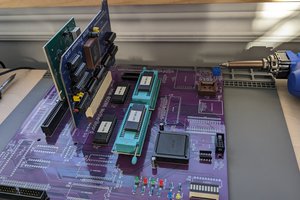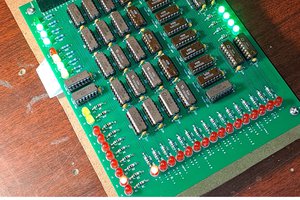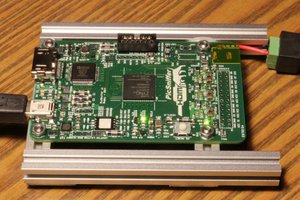Few years ago I bought several pieces of MCY7880, an interesting chip manufactured in Poland back in the eighties, while my country was still a part of the Eastern Bloc. The chip was an unlicensed clone of Intel 8080. Itself it already constituted quite interesting addition to my collection of vintage hardware. But just putting it on a shelf wasn't enough - I decided to build a computer around it, using as many vintage (preferably also Polish) chips as possible.
Designing system based on 8080 clone is not that easy as in case of newer 8- bit CPUs. Chip requires some additional circuits to generate clock and interface memory and IO devices. Also three voltages are required: positive 12V, positive 5V and negative 5V. Fortunately getting original literature about designing such systems turned out to be relatively easy. I also found out there is still a small community of people interesting in tinkering with these very old processors.
First version of POLON 7880 was just a prototype, built on two universal PCBs with a lot of (really lot) wirewrapping wire (just soldered, not wrapped). Some time ago I completed that version of device (at least its hardware part) by finally enclosing it inside nice metal case. But it doesn't mean project is over, because shortly after POLON 7880 mk2 was born. I changed some project assumptions and began designing separate PCB modules. The idea is to make it easier to replicate and debug (lets be honest - looking for broken solder point under mass of tangled wrapping wire is not my idea fun). New design also includes some upgrades - like DMA or floppy controller. I am also going to make it a little bit more "historically accurate" by ditching at least some of anachronistic that hit the market after the era of 8080. Not all of them of course - I can't imagine replacing few SRAM chips with multiple DRAMs requiring additional controller.
I began with designing two boards: first one contains CPU, memory and some glue logic (like address detector or bus buffers). With this one board POLON can do just one thing - blink built in LEDs. Second module is crucial for normal operation - it holds most of the I/O chips (UART, timers, RTC, PS/2 keyboard controller, DMA, interrupt controller) and CF card slot. Two boards combined consist functional 8-bit system running TinyBasic in terminal window.
I also plan adding third board (currently in development) containing graphics and FDD controller. After building this las PCB I will install computer inside metal case, with ATX power supply and floppy drive.
Further plans include porting and executing CP/M on POLON.
 Marek Więcek
Marek Więcek
 Dave Collins
Dave Collins
 Dominic Emond-Belanger
Dominic Emond-Belanger
 Nicolas REIMEN
Nicolas REIMEN
 Marsupilami
Marsupilami